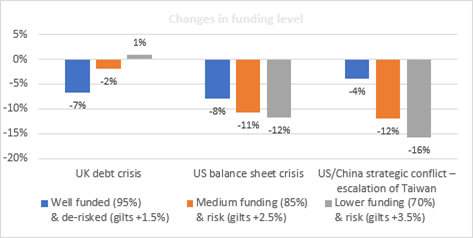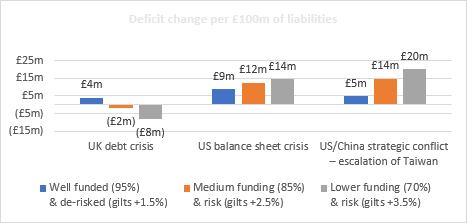The UK debt crisis could see well-funded UK defined benefit (DB) pension schemes’ funding levels fall by 7% and deficits increase by £4m (€4.7m) per £100m of liabilities, according to research from Van Lanschot Kempen.
The firm looked into the potential impact of five future risk scenarios relevant to UK DB schemes in 2024 across well-, medium-, and low-funded schemes and assessed the impact of each risk on funding and deficit levels per £100m of liabilities.
Each example scheme analysed has a different risk profile and investment target return which reflects its respective funding level and asset allocation.
The research models a fall of 7% and 2% in funding levels for well- and medium-funded schemes, respectively, in the event of a UK debt crisis. However, low-funded schemes experience a marginal 1% increase in funding levels.

Deficits for well-funded schemes increase by £4m per £100m of liabilities. However, deficits for medium- and low-funded schemes decrease by £2m and £8m, respectively, in the case of a UK debt crisis.
Alistair Greenlees, head of investment strategy at Van Lanschot Kempen, pointed out that at the end of 2023, the UK debt to GDP ratio stood at 97.7% and in November, estimates from the Office for Budget Responsibility (OBR) put the government’s gross financing requirement at £277bn in 2024-25, or 16% higher than the UK’s debt sales for the previous year.
“In its latest assessment of the world economy, the IMF “advised the UK against further tax cuts” until debt is securely on a downward trajectory, while pockets of the financial services industry have additionally warned of a return to ‘bond vigilantism’ if looser fiscal policy is enacted,” he noted.
Greenlees said: “Our research suggests a UK debt crisis is front of mind for UK DB schemes as well.
“Such an event has the greatest impact on UK Gilts and credit and is a larger risk for well-funded ‘de-risked’ schemes – high corporate credit holdings (which most schemes de-risk towards) present a risk if not carefully managed,” he explained.
“This scenario presents a modest benefit for less well-funded schemes reflecting their lower liability hedges and relatively modest use of credit assets. However, less well funded schemes which employ higher leverage may experience a dual shock through liquidity constraints,” Greenlees said.

US balance sheet crisis
A US balance sheet crisis is also a key risk for most schemes, according to Van Lanschot Kempen.
It said that in some ways this scenario is similar to a UK debt crisis, except all global markets are expected to be affected. The research models a fall of 8%, 11%, and 12% in funding levels and deficit increases of £9m, £12m and £14m per £100m of liabilities for well-, medium-, and low-funded schemes, respectively.
Van Lanschot Kempent said that it is important to consider that certain risk scenarios, while generally bad news for funding levels for all schemes, may have a far more muted impact on deficits.
It pointed out that this could be considered “good news” in the event a scheme’s covenant is simultaneously challenged in this scenario.
It said that covenants may be stretched or improved by changing deficit size (even if funding level is unchanged), particularly if the risk event is likely to be correlated with declining credit availability or trading conditions.
US/China conflict
Another risk scenario considered by Van Lanschot Kempen was US/China strategic conflict which results in an escalation of tensions in Taiwan received the most attention from the wider market.
A significant escalation in tensions between the US and China would impact all risk assets and lead to a flight to safety, the firm noted.
In this scenario, schemes with higher return targets and more investment risk take the largest funding level ‘hit’ due to the expected impact on both equities and from lower levels of liability hedging, it said.
These low-funded schemes would also see funding levels fall by 16% and deficits increase by £20m per £100m of liabilities in such a scenario, according to the research.
Calum Edgar, investment strategist at Van Lanschot Kempen, said that even well-funded, de-risked schemes can still face significant downside risks when considering certain scenarios but the specific risks faced by schemes will be very dependent on funding levels and asset allocation, in particular the approach to liability hedging, credit quality, and equity exposure.
He said: “How can pensions schemes manage tail risks? There is no magic bullet but implementing a bespoke portfolio can help address these specific risks and align risk management strategies appropriately.
“It is crucial to have a partner who can effectively communicate risks and adapt techniques as market conditions evolve, providing schemes with diversification, discretionary-led portfolio dynamism and explicit downside risk management strategies.”
Read the digital edition of IPE’s latest magazine






















No comments yet